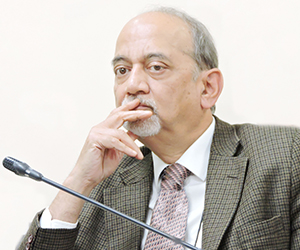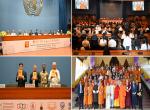Climate change has resulted in the heat wave sweeping the northern hemisphere from the US, Europe, and China to South Korea. India witnessed heavy rains. The UN Secretary-General stated that “The era of global warming has ended; the era of global boiling has arrived,”[1] These extreme weather events have lent urgency to international action for mitigating and adapting to the effects of global warming. India hosted G20 Ministerial meetings on energy transition and climate change in Goa and Chennai. Earlier, the US Special Envoy on Climate Change, John Kerry visited China.
Kerry’s visit did not produce any agreement. He met his counterpart and the Chinese Prime Minister. President XI did not receive Mr. Kerry but made China’s position clear. He stated that ‘The pathways and means for reaching this goal, and the tempo and intensity, should be and must be determined by ourselves, and never under the sway of others.’[2]China is the biggest emitter accounting for 31% of the global emissions followed by the US at 14%. The absence of agreement between the two biggest emitters will cast a shadow over the outcome of the G20 meeting in September and COP 28 in Dubai later this year.
G20 Ministerial Meetings hosted by India in Goa and Chennai produced Outcome Documents on a number of issues where there was a consensus. However, there was no agreement on phasing down fossil fuels, subsidies, and a proposal for tripling renewables by 2030. G20 is a diverse group and cannot remain unaffected by geopolitical tensions. Since the Ukraine war broke out last year, the concern for energy issues has relegated the climate agenda to the background.
The recently concluded BRICS summit at Johannesburg on 23rd August 2023 brought a somewhat different perspective. It advocated ‘just equitable and sustainable transitions’ and called on ‘developed countries to lead by example and support developing countries towards such transition’[3]. It supported ‘efficient use of all energy sources, namely: renewable energy, including biofuels, hydropower, fossil fuels, nuclear energy and hydrogen produced on the basis of zero and low emission technologies and processes.’ It also recognized ‘the role of fossil fuels in supporting energy security and energy transition.’ This is more supportive of the predicament of developing countries that cannot immediately phase out or phase down fossil and gives them broader choices.
Climate negotiations have a tortuous history. The principle of the historical responsibility of developed countries for causing global warming was recognized at the Earth Conference in Rio in 1992. The developed countries were to take action to mitigate or reduce emissions; this did not apply to the developing countries. This was reflected in the Kyoto Protocol. However, the Protocol was not extended beyond the second commitment year in 2012. Since then this principle has all but disappeared in practice. The Net Zero Emissions concept, agreed upon by most countries, entails mitigation commitment on the part of developed and developing countries alike.
The developed countries have exhausted 80% of the carbon budget. They will also consume a disproportionate share of the meager carbon space remaining since their per capita emissions are higher than India’s. Going forward, the per capita emissions of the US will be 9.4 tons, China 8.9 tons, EU-27 4.1 tons, and India 3 tons by 2030.[4]
G7 Summit in Hiroshima called upon all major economies to accept the peaking of emissions by 2025. The EU and the US emissions have already peaked. China has accepted peaking by 2030. This means that while the emissions of the EU countries and the US are on a downward trajectory, Chinese emissions will keep growing. Its relative share of the global commons will be higher in 2030. India has not agreed to the peaking of emissions. It’s per capita consumption of electricity is 1100 units is 1/3rd of the global average. It needs more energy to complete its infrastructure and industrialization.
Energy Transition
The rise in global temperature has intensified pressure for bringing down GHG levels in the atmosphere by replacing fossil fuels with clean energy sources. These could be either renewable or nuclear. According to a UN study, nuclear power has lower life cycle emissions as compared to renewables. The energy transition will have different meanings for different countries. Developed countries have already completed their infrastructure, and enjoy a high standard of living. They do not have to sacrifice development for attaining a clean environment. In the case of developing countries, they have to move towards low emissions while sustaining their growth trajectory.
In India’s case, choosing the renewables option essentially means solar power. Wind power is limited to Tamil Nadu and Gujrat, that too for four months a year. India also has large deposits of coal. Coal combined with CCUS (Carbon-Capture, Use, and Storage) has to be part of the generation mix. The hydro-power is limited. The share of nuclear power in the generation mix is limited to 3 %. This is smaller than nuclear power in most major economies. The US has 20%, EU-28 20%, and Russia 25%. China has currently the same share of nuclear in the generation mix as India but plans to increase it to 10% by 2030.
Prime Minister Modi announced at Glasgow Conference that India will attain net zero emissions (NZE) by 2070. Moving towards NZE entails decarbonizing the entire economy, not just the power sector. The power sector accounts for only 45% of India’s emissions. As additional sectors like mobility, and industry will be brought under electrification based on clean sources, the requirement for electricity will increase sharply beyond the historical level.
A Vivekananda International Foundation Task Force headed by Dr. Kakodkar, the former Chairman of Atomic Energy Commission addressed two critical questions – the minimum amount of electricity needed to attain net zero emissions and the most cost-effective generation mix. The Task Force asked IIT Bombay to do mathematical modeling based on 5 scenarios. These ranged from renewable high (R95N05) to nuclear high (R05N95). There were three other intermediate scenarios with different ratios of coal with Carbon Capture and Storage (CCS). [R = Renewable, CCS Coal with Carbon Capture and Storage and N= Nuclear. The five scenarios are R95N05, R60N10CCS30, R50N20CCS30, R40N35CCS25 and R05N95.]
The VIF study also found that India’s per capita electricity consumption will have to be ramped up from 16,313 kWh (R05N95) to 20,559 kWh (R95N05) per capita by 2070 to achieve net zero emissions.[5] The corresponding requirement of generation according to the VIF report was 30,839 TWh (R95N05) or 24,470 TWh (R05N95) by 2070. This may seem steep as compared to IEA’s projection of the generation required of 3433 TWhr by 2040. The two figures may not be directly comparable given the different timelines. IEA has not provided figures of generation required at NZE stage in 2070. However, it is worth bearing in mind that India’s energy consumption in 2020 based on NITI Aayog figures was 6292 TWhr. Its energy consumption two decades later cannot be half of the energy consumption in the pandemic year.
Another key finding was that the nuclear high scenario (R05N95) at $ 11.2 trillion would be the cheapest option, while the renewable high scenario (R95N05) at $ 15.5 trillion will be the most costly.[6] The results may appear surprising as the popular perception is that renewable tariffs have kept falling. However, the tariff structure of renewables does not take into account ‘systems costs’. These include the cost of balancing power and transmission charges. Renewables are an intermittent source of energy with low Plant Load Factor (PLF). When the sun is not shining and the wind is not blowing, a standby facility is needed to supply electricity to the grid. On the other hand, when renewable is available, this capacity has to be operated at a sub-optimal level or not operated at all. The cost of this balancing power is not included in the tariff structure in India. The Forum of Regulators estimated in a report covering Tamil Nadu and Gujarat this cost as Rs. 2.12 paisa per unit. This added to the existing tariff of Rs. 2 per unit for solar power will make the cost of renewables to be Rs. 4.12 paisa per unit. This makes it more costly than either coal at Rs. 3.25 paisa per unit or nuclear at Rs. 3.47 paisa per unit. [7]
Earlier, an OECD/MIT study pointed out that as against 100 GW capacity where nuclear power is included in the generation mix, renewable with battery solution will require 600 GW of capacity to reach the 1 g/kWh of emission target.[8]The higher capacity build-up required in the case of renewables pushes up the cost.
Land Constraints
The land is a major constraint in India. Renewables have a much larger footprint than nuclear power. India has around 2, 00,000 square km of surplus land according to a study by Prof. Sukhatme. The VIF study found that a renewable high approach (R95N05) will require 4, 12,033 square km of land. The land required in case of the nuclear high scenario will be more manageable – 1, 83,565 square km.
Transmission Costs
Given the extensive land requirement, most new ultra-mega renewable power plants will come up in remote areas like Ladakh and Kutch which will increase the length of transmission lines and cost. The Power Ministry is planning to spend 2.440 billion rupees ($ 30 billion) to build 50,000 km of transmission lines by 2030.[9]
Finance
The developed countries committed $ 100 billion per annum to the developing countries in the Paris Conference. Actual assistance is yet to reach this level. A recent report by Larry Summers – N. K. Singh suggested that ‘sustainable lending levels at the MDBs need to triple by 2030, rising to about $ 400 billion annually.’[10] Is this enough? India as G20 Chair has estimated an annual requirement of $ 4 trillion. A study by McKinsey has estimated that energy transition will require an investment of $ 9.5 trillion per annum or about $ 3.5 trillion more than today at the global level.[11]
Larry Summers- N.K. Singh report has suggested that MDBs can leverage more funds from private sources. The report states ‘Every donor dollar could yield $ 7 in new sovereign lending and another $ 8 in the direct and indirect mobilization of private capital.’[12] How realistic is this estimate? The lowering of the World Bank’s equity-to-loan ratio from 20% to 19% recently is expected to yield $ 5 billion. [13]Considering the resource requirement of $ 9.2 trillion, including additional resources to the tune of $ 3.5 trillion over present expenditure estimated by McKinsey, and $ 4 trillion per annum estimated by India Chair of G20, this is insignificant.
It is also worth bearing in mind that green financing based on private funding will come only if the tariff goes up. We have therefore difficult choices. The bulk of the resources needed for energy transition will have to be raised through domestic sources. This will require restoring the health of the DISCOMs.
Rapid ramping up of the nuclear portfolio will require government support since nuclear power is in the government sector under Atomic Energy Act. Given the worsening climate situation, these are difficult, but unavoidable choices.
Endnotes
[1]CNBC, The era of global boiling has arrived, says UN boss, as White House announces provisions to protect workers from extreme heat, July 27, 2023
[2]The New York Times, China’s Xi Rebuffs Kerry’s Call for Faster Climate Action, July 19, 2023
[3]BRICS, South Africa, Johannesburg II Declaration, 23 August 2023.
[4]VIF Task Force Report on India’s Energy Transition in a Carbon-Constrained World, Page 61, citing Down to Earth and Center for Science and Environment. (2021). Carbon Budget Target 2030: How It Ends
[5]VIF Task Force Report on India’s Energy Transition in a Carbon-Constrained World
[6]VIF Task Force Report on India’s Energy Transition in a Carbon-Constrained World
[7]VIF Task Force Report on India’s Energy Transition in a Carbon-Constrained World
[8]VIF Task Force Report on India’s Energy Transition in a Carbon-Constrained World, Page 149 citing OECD report The Cost of Decarbonization: Systems Cost with a High Share of Nuclear and Renewables
[9]The Economist, April 8th, 2023, Technology Quarterly, Page 7
[10]Project Syndicate, The Multilateral Development Banks the World Needs by Lawrence H. Summers and N.K.Singh, July 24, 2023
[11]VIF Task Force Report on India’s Energy Transition in a Carbon-Constrained World, Page 46 citing McKinsey (2022) The Net Zero Transition: What it Would Cost, What It Could Bring
[12]Project Syndicate, The Multilateral Development Banks the World Needs by Lawrence H. Summers and N.K.Singh, July 24, 2023
[13]WSJ, Climate Change and Poverty Pose Challenge to World Bank by Yuka Hayashi and Andrew Duehrn, April 10, 2023
(The paper is the author’s individual scholastic articulation. The author certifies that the article/paper is original in content, unpublished and it has not been submitted for publication/web upload elsewhere, and that the facts and figures quoted are duly referenced, as needed, and are believed to be correct). (The paper does not necessarily represent the organisational stance... More >>
Image Source: https://www.enterprise-tocsin.com/sites/default/files/ap_newsroom/e52bd6806c5c40a22a4078de17f45bcc/China_US_Climate_88373_0.jpg











Post new comment